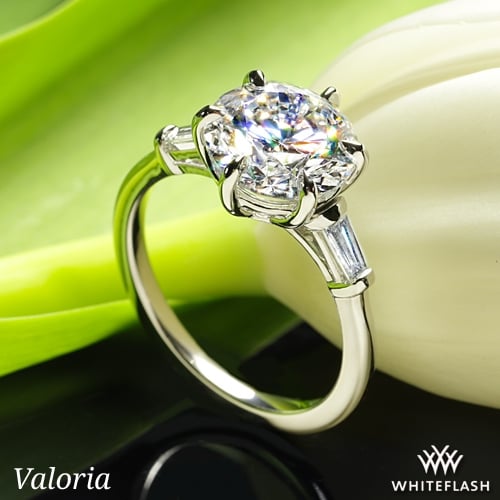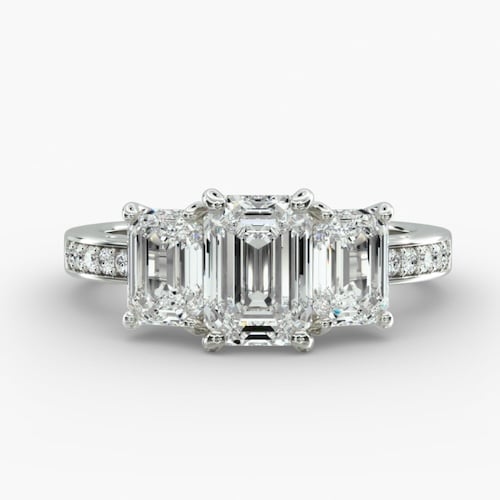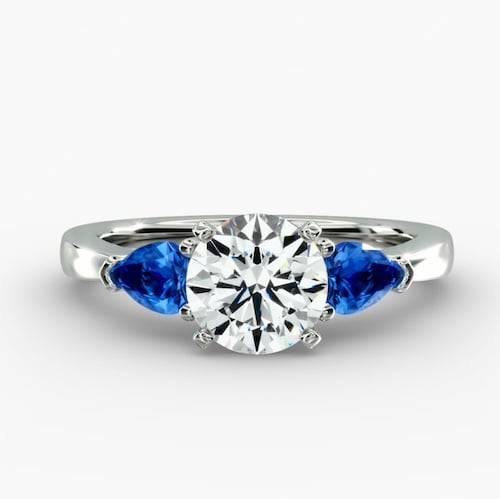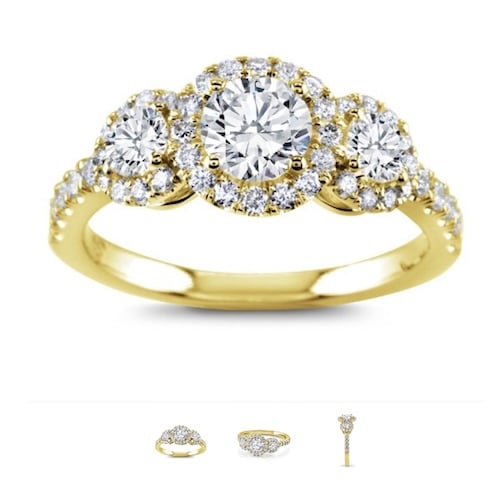Past, Present, Future: The Meaning of Three-Stone Engagement Rings
The Design Structure: Center Stone and Side Stones
The defining feature of a three-stone ring is its composition: a prominent center stone supported by two smaller side stones. The center stone is typically the largest and draws the most visual focus, while the side stones are chosen to complement its size, shape, and overall presence.
The design works well across a wide range of diamond shapes. Some rings use three matching stones for a uniform look – three round brilliants, for example. Others mix shapes for contrast, such as a round center flanked by pear-shaped or baguette side stones. The side stones can enhance the shape of the center diamond or add character to the setting.
This structure allows for a high degree of personalization while still maintaining a balanced, symmetrical layout. It’s a style that looks refined from every angle and suits a variety of finger shapes and hand sizes.
Popular Stone Combinations and Settings
Three-stone rings can be fully diamond or feature a mix of diamonds and colored gemstones. Sapphires, rubies, and emeralds are frequently chosen for side stones, either to add visual interest or infuse the ring with symbolic meaning. For example, blue sapphires can represent loyalty or a birthstone.
Some of the most popular combinations include:




As for settings, prong is the most common, allowing maximum light to enter each stone. Trellis settings offer an elegant twist with curved metal work connecting the stones. Bezel and bar settings offer a more modern look with added protection.
Your choice of metal—platinum, white gold, yellow gold, or rose gold—also plays a role in the overall feel of the ring. Platinum and white gold tend to enhance brilliance and lean considerably more contemporary, while yellow or rose gold add warmth and vintage character.
Choosing the Right Proportions and Balance
The visual harmony of a three-stone ring depends on how well the stones work together in size, shape, and cut quality. The center stone is typically the largest, but the side stones should be proportioned to enhance,not overpower.. Most designs feature side stones that are half to two-thirds the size of the center, creating a balanced and elegant profile.
Beyond size, symmetry is key. Mismatched shapes or poorly aligned stones can throw off the ring’s visual flow. If you’re combining shapes, ensure the proportions still feel cohesive.For example, pear-shaped sides should taper naturally away from a round or oval center.
Cut quality should be the top priority for all diamond engagement rings. A well-cut diamond reflects more light, giving the entire ring a cohesive brilliance. This is especially important in three-stone settings, where uneven light return between stones can be noticeable.
Equally important is choosing a reputable vendor—one that offers high-resolution images, cut performance data, and full certification for all diamonds. This ensures that what looks good online performs just as well in person. Stick with sellers who prioritize precision and can guide you in pairing the right shapes and sizes for a well-balanced, beautifully finished ring.
Customizing a Three-Stone Ring
A three-stone ring offers more flexibility than most engagement ring styles, making it a strong choice for those who want a personalized design. Customization can be as simple as selecting meaningful side stones—such as a birthstone or anniversary gem—or as detailed as choosing specific shapes to reflect a partner’s style.
Some couples choose symbolic gems for the side stones (like sapphires for loyalty or emeralds for growth), while others prefer three diamonds of the same shape for a clean, classic look. As mentioned, the choice of metal also adds personality. Platinum for durability and brightness, yellow gold for a traditional warmth, or rose gold for a soft, romantic tone.
Small details like the gallery design, prong style, and band width can further tailor the ring to your preferences.

